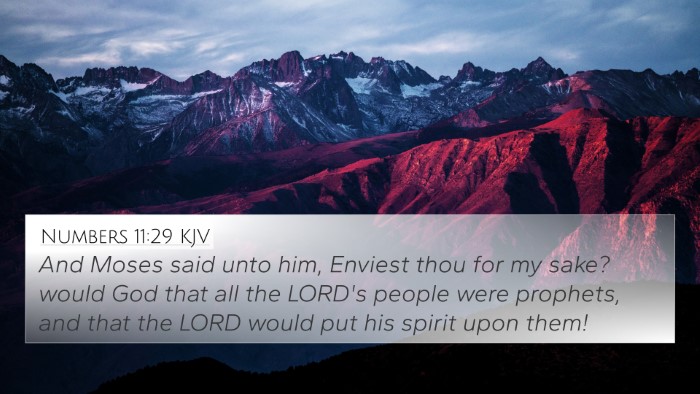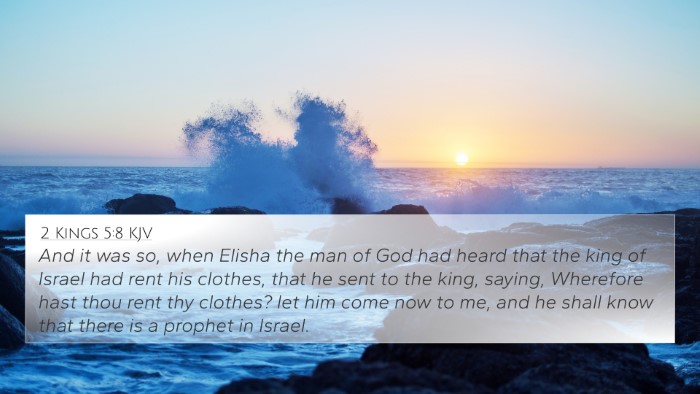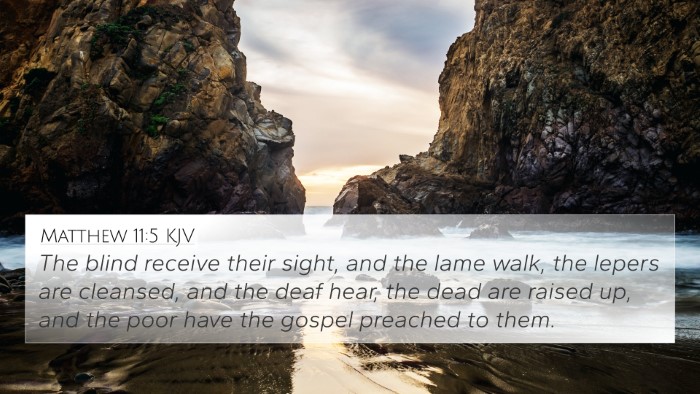Understanding 2 Kings 5:3
The verse 2 Kings 5:3 states: "And she said unto her mistress, Would God my lord were with the prophet that is in Samaria! for he would recover him of his leprosy." This brief yet profound verse speaks volumes about faith, hope, and intercession. Below, we delve into a combined interpretation from various public domain commentaries, providing insight into its meaning and significance.
Key Themes and Insights
-
Faith and Intercession:
The young maiden’s suggestion to her mistress exemplifies faith in the power of God’s prophets. She believed that if her master Naaman were to visit Elisha, the prophet in Samaria, he would be healed. This shows her deep conviction in God’s ability to work miracles through His messengers.
-
The Role of the Servant:
This verse highlights the often-overlooked position of servants in biblical narratives. Despite her lowly status, the servant girl plays a crucial role in pointing Naaman towards healing, emphasizing that God can work through anyone, regardless of their societal position.
-
Divine Providence:
The mention of the prophet in Samaria underscores God’s providence in the narrative. The young maid’s position as a captive servant becomes a vessel for divine purpose, reinforcing the theme that God can use adverse situations for good.
-
Hope Amidst Affliction:
Naaman's leprosy symbolizes a desperate situation. The young maiden's words convey hope, demonstrating the significance of having faith in a seemingly hopeless condition.
Bible Cross References and Related Scriptures
Understanding the connections between Bible verses can enrich the interpretation of this verse. Here are several related scriptures that reveal thematic connections and provide a broader understanding:
-
2 Kings 5:14: This verse recounts Naaman's healing after he follows the prophet’s instructions, highlighting the necessity of obedience.
-
2 Kings 4:27: Here, we see another example of the faith of a woman, reflecting on how God uses ordinary people for His purposes.
-
Luke 4:27: Jesus references Naaman's healing, establishing a continuity in God’s work across the testaments.
-
James 5:15: This New Testament verse emphasizes the power of prayer and how faith can lead to healing, paralleling the faith expressed by the young maid.
-
Matthew 8:13: The centurion's faith in Jesus echoes the belief seen in the servant girl's suggestion.
-
Hebrews 11:1: This foundational scripture on faith ties the theme of hope and delivered faith together in the context of miraculous healing.
-
John 14:12: Jesus discusses believers doing greater works, which relates to the role of the prophet in performing miracles.
-
2 Chronicles 20:20: This verse teaches about the faithfulness of God when one trusts in His prophets.
-
Proverbs 3:5-6: A timeless principle of trusting in the Lord and the direct paths He provides, similar to the guidance given in this narrative.
-
Psalm 107:20: God sends His word to heal and deliver, echoing the message of healing through the prophet.
Comparative and Thematic Analysis
An analysis of 2 Kings 5:3 in correlation with surrounding texts reveals overarching themes of faith, healing, and God's intervention in human life. The young maiden’s proclamation is a key moment that sparks Naaman’s journey towards healing. Through cross-referencing these passages, we observe a consistent message within the Scriptures that emphasizes hope and the power of divine healing.
Conclusion
2 Kings 5:3 serves as a reminder of the strength that lies in faith and the willingness to look beyond one’s circumstances for divine intervention. The insights drawn from public domain commentaries illuminate the importance of being open to the ways in which God may choose to guide and heal, demonstrating that even those in lowly positions can significantly influence the course of events through their faith.
Tools for Further Study
For those interested in deeper analysis, several resources can aid in exploring the connections and themes throughout the Bible:
- Use a Bible concordance to identify key themes and verse references.
- Employ a Bible cross-reference guide to understand thematic connections.
- Explore cross-reference Bible study methods for effective group studies or personal reflection.









